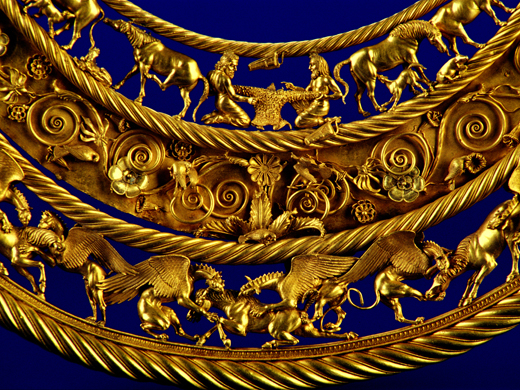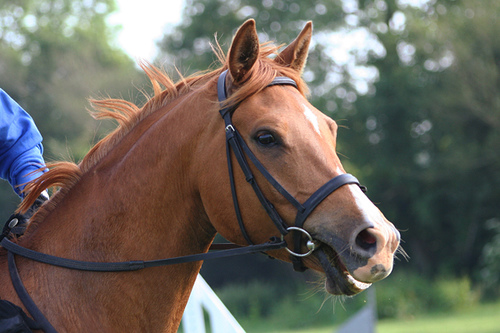|
Eurasian Nomads
The Eurasian nomads were a large group of nomadic peoples from the Eurasian Steppe, who often appear in history as invaders of Europe, Western Asia, Central Asia, Eastern Asia, and South Asia. A nomad is a member of people having no permanent abode, who travel from place to place to find fresh pasture for their livestock. The generic title encompasses the varied ethnic groups who have at times inhabited the steppes of Central Asia, Mongolia and what is now Russia and Ukraine. They domesticated the horse around 3500 BCE, vastly increasing the possibilities of nomadic life and subsequently their economy and culture emphasised horse breeding, horse riding and nomadic pastoralism; this usually involved trading with settled peoples around the steppe edges. They developed the chariot, wagon, cavalry and horse archery and introduced innovations such as the bridle, bit and stirrup and the very rapid rate at which innovations crossed the steppelands spread these widely, to be copied ... [...More Info...] [...Related Items...] OR: [Wikipedia] [Google] [Baidu] |
Cerf D'or Scythe
Cerf or CERF may refer to: * CERF (Central Emergency Response Fund), a United Nations fund created to aid regions threatened by disaster * Coastal and Estuarine Research Federation (CERF) * Cerf (surname) * Cerf Island, Seychelles * Cerf Island, Providence Atoll, Seychelles * , a brig (also named ''Cerf'') captured from the French See also * Île aux Cerfs Île aux Cerfs (in English: ''Deer Island'') is a privately owned island near the east coast of Mauritius in the Flacq District Flacq () is a district of Mauritius, situated in the east of the island. It is the largest district, having an ar ... * Les Éditions du Cerf, a French publisher {{disambiguation, geo ... [...More Info...] [...Related Items...] OR: [Wikipedia] [Google] [Baidu] |
Chariot
A chariot is a type of cart driven by a charioteer, usually using horses to provide rapid motive power. The oldest known chariots have been found in burials of the Sintashta culture in modern-day Chelyabinsk Oblast, Russia, dated to c. 2000 BCE. The critical invention that allowed the construction of light, horse-drawn chariots was the spoked wheel. The chariot was a fast, light, open, two- wheeled conveyance drawn by two or more horses that were hitched side by side, and was little more than a floor with a waist-high guard at the front and sides. It was initially used for ancient warfare during the Bronze and Iron Ages, but after its military capabilities had been superseded by light and heavy cavalries, chariots continued to be used for travel and transport, in processions, for games, and in races. Etymology The word "chariot" comes from the Latin term ''carrus'', a loanword from Gaulish. In ancient Rome and some other ancient Mediterranean civilizations, a '' b ... [...More Info...] [...Related Items...] OR: [Wikipedia] [Google] [Baidu] |
Scythia
Scythia (Scythian: ; Old Persian: ; Ancient Greek: ; Latin: ) or Scythica (Ancient Greek: ; Latin: ), also known as Pontic Scythia, was a kingdom created by the Scythians during the 6th to 3rd centuries BC in the Pontic–Caspian steppe. History Background Origins of the Scythians The Scythians originated in Central Asia possibly around the 9th century BC, and they arrived in the Caucasian Steppe in the 8th and 7th centuries BC as part of a significant movement of the nomadic peoples of the Eurasian Steppe. This movement started when another nomadic Iranian tribe closely related to the Scythians, either the Massagetae or the Issedones, migrated westwards, forcing the Early Scythians to the west across the Araxes river, following which the Scythians moved into the Caspian Steppe, where they conquered the territory of the Cimmerians, who were also a nomadic Iranian people closely related to the Scythians, and assimilated most of them while displacing the rest, before settling ... [...More Info...] [...Related Items...] OR: [Wikipedia] [Google] [Baidu] |
Cumania (1200) Eng
The name Cumania originated as the Latin exonym for the Cuman–Kipchak confederation, which was a tribal confederation in the western part of the Eurasian Steppe, between the 10th and 13th centuries. The confederation was dominated by two Turkic nomadic tribes: the Cumans (also known as the Polovtsians or ''Folban'') and the Kipchaks. Cumania was known in Islamic sources as ''Desht-i Qipchaq'', which means "Steppe of the Kipchaks"; or "foreign land sheltering the Kipchaks", in Persian and ''al-Qumāniyīn'' in Arabic. Russian sources have referred to Cumania as the "Polovtsian Steppe" (''Polovetskaia Step''), or the "Polovtsian Plain" (''Pole Polovetskoe''). A different, more organized entity that came later known as the Golden Horde was also referred to as "Comania" by Armenian chronicler Hethum (Hayton) of Korykos. "Cumania" was also the source of names, or alternate names, for several smaller areas – some of them unconnected geographically to the area of the federation ... [...More Info...] [...Related Items...] OR: [Wikipedia] [Google] [Baidu] |
Scythian Art
Scythian art is the art associated with Scythian cultures, primarily decorative objects, such as jewellery, produced by the nomadic tribes of the area known as Scythia, which encompassed Central Asia, parts of Eastern Europe east of the Vistula River, and parts of South Asia, with the eastern edges of the region vaguely defined by ancient Greeks. The identities of the nomadic peoples of the steppes is often uncertain, and the term "Scythian" should often be taken loosely; the art of nomads much further east than the core Scythian territory exhibits close similarities as well as differences, and terms such as the "Scytho-Siberian world" are often used. Other Eurasian nomad peoples recognised by ancient writers, notably Herodotus, include the Massagetae, Sarmatians, and Saka, the last a name from Persian sources, while ancient Chinese sources speak of the Xiongnu or Hsiung-nu. Modern archaeologists recognise, among others, the Pazyryk, Tagar, and Aldy-Bel cultures, with the furt ... [...More Info...] [...Related Items...] OR: [Wikipedia] [Google] [Baidu] |
Scythian Cultures
The Scytho-Siberian world was an archaeological horizon which flourished across the entire Eurasian Steppe during the Iron Age from approximately the 9th century BC to the 2nd century AD. It included the Scythian, Sauromatian and Sarmatian cultures of Eastern Europe, the Saka- Massagetae and Tasmola cultures of Central Asia, and the Aldy-Bel, Pazyryk and Tagar cultures of south Siberia. The Scythian-Siberian world was characterized by the Scythian triad, which are similar, yet not identical, styles of weapons, horses' bridles, and jewelry and decorative art. The question of how related these cultures were is disputed among scholars. Its peoples were of diverse origins, and included not just Scythians, from which the cultures are named, but other peoples as well, such as the Cimmerians, Massagetae, Saka, Sarmatians, and obscure forest steppe populations. Mostly speakers of the Scythian branch of the Iranian languages, all of these peoples are some ... [...More Info...] [...Related Items...] OR: [Wikipedia] [Google] [Baidu] |
Iron Age
The Iron Age is the final epoch of the three-age division of the prehistory and protohistory of humanity. It was preceded by the Stone Age ( Paleolithic, Mesolithic, Neolithic) and the Bronze Age ( Chalcolithic). The concept has been mostly applied to Iron Age Europe and the Ancient Near East, but also, by analogy, to other parts of the Old World. The duration of the Iron Age varies depending on the region under consideration. It is defined by archaeological convention. The "Iron Age" begins locally when the production of iron or steel has advanced to the point where iron tools and weapons replace their bronze equivalents in common use. In the Ancient Near East, this transition took place in the wake of the Bronze Age collapse, in the 12th century BC. The technology soon spread throughout the Mediterranean Basin region and to South Asia (Iron Age in India) between the 12th and 11th century BC. Its further spread to Central Asia, Eastern Europe, and Central Europe is ... [...More Info...] [...Related Items...] OR: [Wikipedia] [Google] [Baidu] |
Stirrup
A stirrup is a light frame or ring that holds the foot of a rider, attached to the saddle by a strap, often called a ''stirrup leather''. Stirrups are usually paired and are used to aid in mounting and as a support while using a riding animal (usually a horse or other equine, such as a mule). They greatly increase the rider's ability to stay in the saddle and control the mount, increasing the animal's usefulness to humans in areas such as communication, transportation, and warfare. In antiquity, the earliest foot supports consisted of riders placing their feet under a girth or using a simple toe loop appearing in India by the 2nd century BC. Later, a single stirrup was used as a mounting aid, and paired stirrups appeared after the invention of the treed saddle. The stirrup was invented in China in the first few centuries AD and spread westward through the nomadic peoples of Central Eurasia.Dien, Albert"The Stirrup and Its Effect on Chinese Military History" Accessed Januar ... [...More Info...] [...Related Items...] OR: [Wikipedia] [Google] [Baidu] |
Bit (horse)
The bit is an item of a horse's tack. It usually refers to the assembly of components that contacts and controls the horse's mouth, and includes the shanks, rings, cheekpads and mullen, all described here below, but it also sometimes simply refers to the ''mullen'', the piece that fits inside the horse's mouth. The mullen extends across the horse's mouth and rests on the ''bars'', the region between the incisors and molars where there are no teeth. The bit is located on the horse's head by the , and which has itself several components to allow the most comfortable adjustment of bit location and control. The bit, bridle and reins function together to give control of the horse's head to the rider. The bit applies pressure to the horse's mouth, and reinforces the other control signals from the rider's legs and weight distribution. A well schooled horse needs little pressure on the bit from a skilled rider. Studies have indicated that soft, consistent bit contact between the rider ... [...More Info...] [...Related Items...] OR: [Wikipedia] [Google] [Baidu] |
Bridle
A bridle is a piece of equipment used to direct a horse. As defined in the ''Oxford English Dictionary'', the "bridle" includes both the that holds a bit that goes in the mouth of a horse, and the reins that are attached to the bit. Headgear without a bit that uses a noseband to control a horse is called a hackamore, or, in some areas, a bitless bridle. There are many different designs with many different name variations, but all use a noseband that is designed to exert pressure on sensitive areas of the animal's face to provide direction and control. Parts The bridle consists of the following elements: * Crownpiece: The crownpiece, headstall (US) or headpiece (UK) goes over the horse's head just behind the animal's ears, at the poll. It is the main strap that holds the remaining parts of the bridle in place. * Cheekpieces: On most bridles, two cheekpieces attach to either side of the crownpiece and run down the side of the horse's face, along the cheekbone and attach t ... [...More Info...] [...Related Items...] OR: [Wikipedia] [Google] [Baidu] |






